Károly Zipernowsky
b. April 4, 1853, Wien, Austria
d. November 29, 1942, Budapest, Hungary
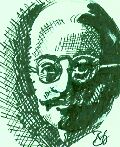
|
Károly Zipernowsky was an electrical engineer (later director)
of the Ganz Works Company (Hungary) where he invented transformer together
with his colleagues Miksa Déri and Titusz Ottó Bláthy.
This was the main step in the achievement of long-distance electrical power
transmitting. He also made many other contributions to electrical engineering. |
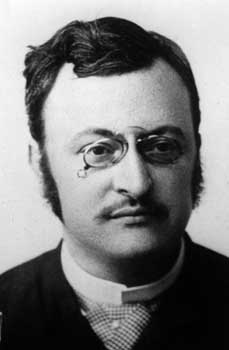
|
Károly Zipernowsky was born on April 4, 1853, in Vienna, Austria,
in the family of Josef Zipernowsky, a bookkeeper, and Franziska Zipernowsky,
nee Fischer. Károly received his primary education the Piarist grammar
school in Pest, but he did not make his way directly towards the Technical
University. He came to the idea of becoming an engineer during his pharmacist
years in Kecskemét. Having worked as an apothecary for three years,
he matriculated to the faculty of mechanical engineering of the Technical
University. His interest gradually brought him to the electrical engineering.
When he was a fourth-year student, he already gave lectures at the meetings
of the Engineers' Society on the subject of electrical engineering. During
his university years, he worked as a draftsman in the office of the Austrian
State Railway Company and in his little free time, he created electrical
appliances. He completed his studies with excellent marks. His way led
him to the Ganz Works Company. |
 |
In 1878 András Mechwart, the Ganz factory's managing director
entrusted him with organizing their electricity department. Since Ganz
was the first factory in Hungary engaged in electricity, it thus became
his task to develop the power industry in Hungary. Under Zipernowsky's
leadership the factory soon became the pioneer in AC electroindustry. In
1883 the National Theater of Budapest was lighted by the Ganz company:
this was the first alternating current, incandescent lighting system in
Hungary (the third theater in the world after the Savoy in London and the
theatre in Brünn [now Brno]). "Our locomobile - driven generators
supplied 1,000 incandescent lamps of twenty candle power each. We were
all in great joy," Zipernowsky remembered the great moment. It is worth
mentioning that one of their AC generators, the "giant steam lighting machine",
illuminated the Keleti Railway Station for thirty years. |
However, all lighting systems that time had to use a local generator,
as there was no method available for transporting electric power. This
seriously handicapped the more widespread use of electric power, and experiments
were conducted in many places to solve this problem. Edison had solved
the problem of carrying light economically to short distances with DC (direct
current).
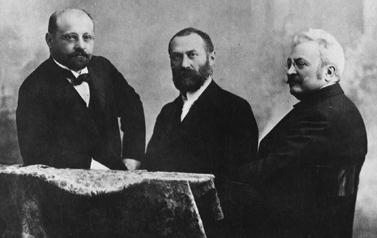
Electrical engineers Miksa Déri, Titusz Ottó Bláthy
and Károly Zipernowsky, the 1900s
|
Historical credit should be given to Zipernowsky and his colleagues
for developing the economical transmission and distribution of light to
long distances. The first practical solution was found in Budapest, at
the Ganz factory. In 1885 three engineers, Károly Zipernowsky, Miksa
Déri and Titusz Ottó Bláthy, after one year of research
and development invented a device of two coils with a closed iron core,
with variable ratio induction, which they called a transformer, the name
used ever since that time. |
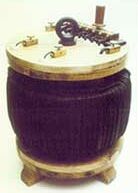
|
This device was the basis of alternative current (AC) power distribution
networks. Such a network was installed at the National General Exhibition
in Budapest (May to November 1885) where the system worked faultlessly
without interruption. |
The Zipernowski and Deri Transformer
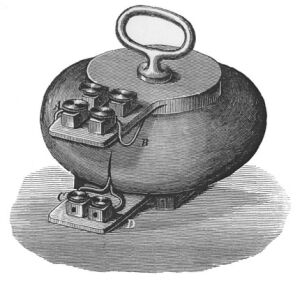
|
One of the best of the early ring-shaped transformer was presented
by Károly Zipernowsky, Miksa Déri and Titusz Ottó
Bláthy in 1885. In this transformer, which was electrical excellent
though mechanically not very sound, the positions of the coils and the
iron were reversed. The primary and secondary coils, both thoroughly insulated,
was wound into a kind of solid core and over-wound with a heavy layer of
iron wire. They also took a crucial step in March 1885. This comprised
of three major elements.
•Rejecting series connection and connecting transformers that supply
the consuming equipment groups in parallel to the main line,
•Applying high-ratio transformers, separating high-voltage (1400-2000
V) wide supply network from low-voltage (100 V) consumer networks, and
•Developing a transformer with closed iron core, low drop (i.e. terminal
voltage is almost independent of the load), and low loss. |
During the following decades, the Ganz factory manufactured and installed
several hundred power distribution systems using their own components.
In 1886 they installed the Rome-Cerchi steam power plant, the first power
plant built to supply a large city with electricity. This was the very
first power plant which used, on the proposal of Bláthy, AC generators
to supply a common network in parallel connection. The Ganz factory produced
electrical equipment for the power network of the city of Rome over several
decades. In the course of his activity at the Ganz Works, Zipernowsky had
got 40 patents. His patent entitled 'Invention for three-phase alternating
current induction motors' was submitted together with Kálmán
Kandó in 1894, the purpose of which was to improve the starting
conditions of induction motors.
At the Technical University, new curricula were introduced in the 90s,
initiating the instruction of new fields of science which implied the establishment
of new departments, rather than introducing organizational changes. Since
the significance of electrical engineering got greater and greater in the
course of these years, the management of the Technical University decided
to establish an independent department of electrical engineering, inviting
Károly Zipernowsky to be professor there without a competition.
He arrived at the Technical University with considerable industrial experience.
He left the directorship of the Ganz Works in order to be a scholarly teacher
of engineers. And this, at the same time, put an end to the brilliant practical
activity, as a result of which the electrical section of the Ganz Works
was turned into a world-famous factory from an experimental workshop in
less than 15 years. By his inventions, he gained fame not only for himself,
but for Hungary as well.
In this period, more and more teachers with considerable industrial
experience were working at the Technical University, such as, for example,
Donát Bánki, Antal Kherndl, Emil Schimanek, and Vince Wartha.
And this group was enriched by Károly Zipernowsky. At the section
of mechanical engineering (now to be called faculty) of the University,
more and more students were studying. What was taught at the department
of electrical engineering at that time? Measurements to be performed on
dynamo machinery and transformers, the equipment of electric plants, the
transmission and distribution of mechanical energy by the use of electric
current, a subject on electric railways, and there was an electric measurement
practice as well.
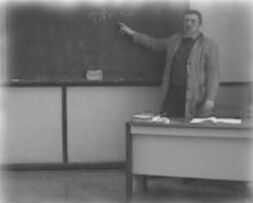
Zipernowsky teaching
|
Károly Zipernowsky normally started his lectures at the Technical
University at 11 o'clock a.m. Although the door to his room was always
open to his colleagues and students, he preferred not to be disturbed during
the hours before his lectures. |
In spite of the shortage of material resources, he supplied his department
with lots of experimenting and measuring equipment. The laboratory devices
for measurement practices were made on the basis of his experience. His
ingenuity was inexhaustible. He used huge wall instruments to display experiments.
He illustrated his lectures with slides. To his department, he took in
several periodicals from abroad, requiring his colleagues to read them
continuously. "If we want to go before the world, we should know where
the others are going. We should not just follow them." In the course of
the subject titled 'Dynamo machinery', he dealt with the theory of direct
current machines and with alternating current machinery as well. The material
taught was completed by the elaboration of numerous examples. Surrounded
by the love and respect of his colleagues and students, he worked at the
Technical University till his retirement in 1924. He spent 32 years within
the walls of the University.
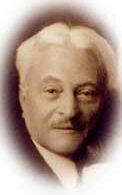
|
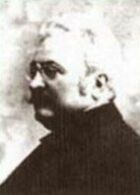
|
Károly Zipernowsky became corresponding member of the Hungarian
Academy of Sciences in 1893, and president of the Hungarian Society of
Electrical Engineers in 1905. His knowledge of German, French, and English
connected him to experts living in many countries of the world throughout
his plentiful life. |

|
Károly Zipernowsky was married on Anna Klein and they had three
children. |
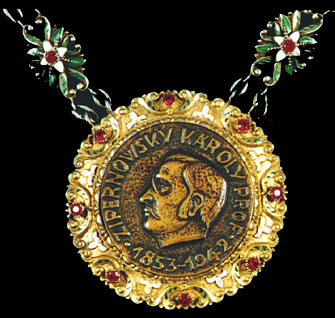
Zipernowsky Medal established by the
Hungarian Society of Electrical Engineers
|
The award created by the Hungarian Society of Electrical Engineers
in 1911 bears his name. Károly Zipernowsky died on 29 November,
1942, in Budapest at the age of 90. |
 This
text has been compiled from the biographies of Zipernowsky
available in the Internet:
This
text has been compiled from the biographies of Zipernowsky
available in the Internet:
( 1,
2
).
 (updated & corrected on May 3, 2003)
(updated & corrected on May 3, 2003)










